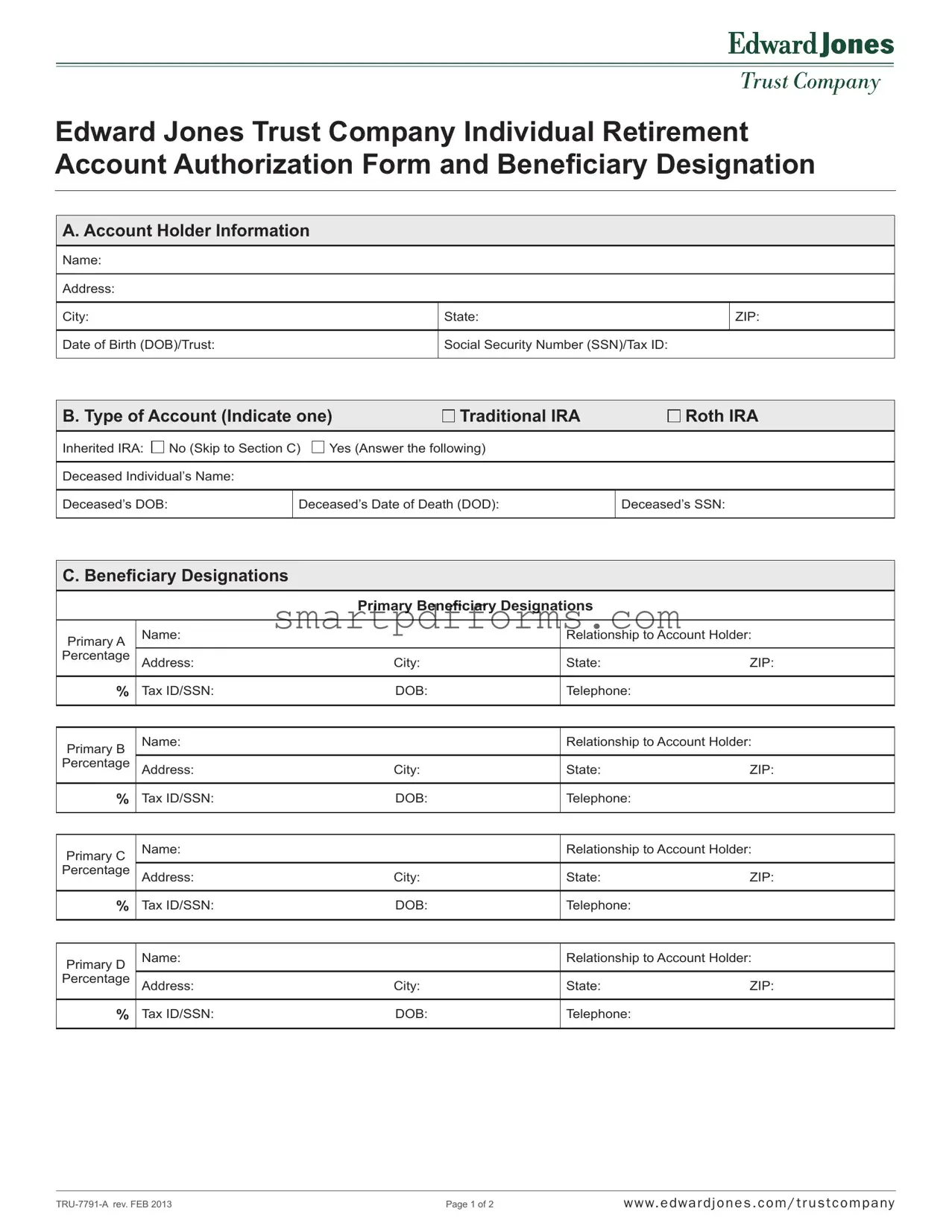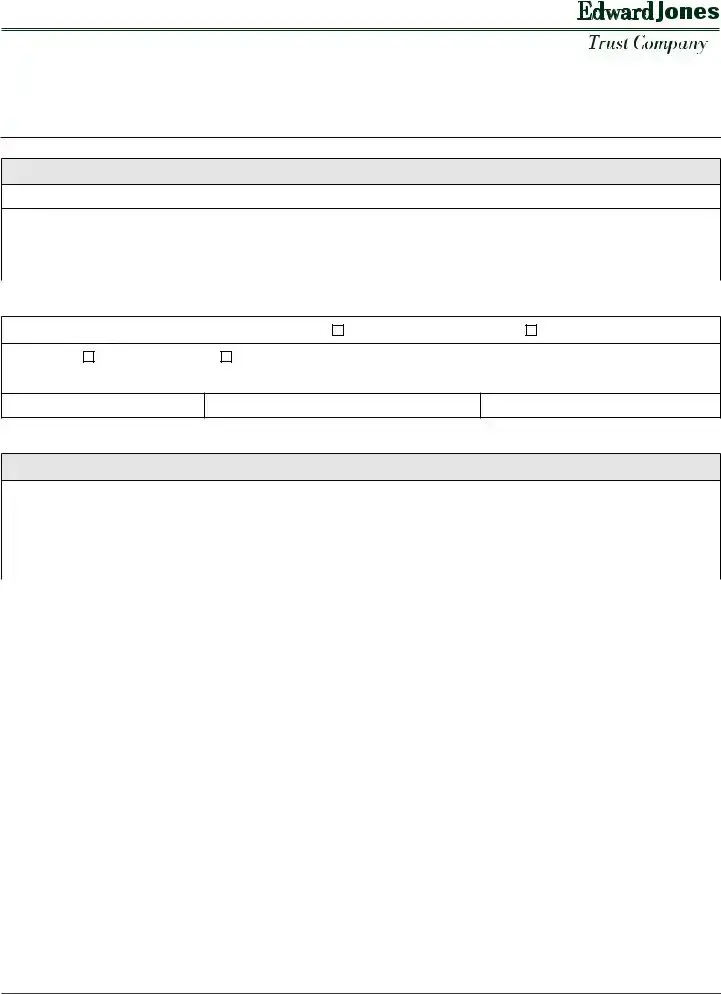Edward Jones Trust Company Individual Retirement Account Authorization Form and Beneiciary Designation
A. Account Holder Information
Name:
Address:
City: |
State: |
ZIP: |
|
|
|
Date of Birth (DOB)/Trust: |
Social Security Number (SSN)/Tax ID: |
|
|
|
|
B. Type of Account (Indicate one) |
Traditional IRA |
Roth IRA |
|
|
|
Inherited IRA: |
No (Skip to Section C) |
Yes (Answer the following) |
|
|
Deceased Individual’s Name: |
|
Deceased’s Date of Death (DOD):
C. Beneiciary Designations
Primary Beneiciary Designations
Primary A |
Name: |
|
Relationship to Account Holder: |
Percentage |
Address: |
City: |
State: |
ZIP: |
|
|
|
|
|
% |
Tax ID/SSN: |
DOB: |
Telephone: |
|
|
|
|
|
|
|
|
|
Primary B |
Name: |
|
Relationship to Account Holder: |
Percentage |
Address: |
City: |
State: |
ZIP: |
|
|
|
|
|
% |
Tax ID/SSN: |
DOB: |
Telephone: |
|
|
|
|
|
|
|
|
|
Primary C |
Name: |
|
Relationship to Account Holder: |
Percentage |
Address: |
City: |
State: |
ZIP: |
|
|
|
|
|
% |
Tax ID/SSN: |
DOB: |
Telephone: |
|
|
|
|
|
|
|
|
|
Primary D |
Name: |
|
Relationship to Account Holder: |
Percentage |
Address: |
City: |
State: |
ZIP: |
|
|
|
|
|
% |
Tax ID/SSN: |
DOB: |
Telephone: |
|
|
|
|
|
|
TRU-7791-A rev. FEB 2013 |
Page 1 of 2 |
w w w. e dwa r d j o n e s . c o m / t r u s t c o m p a ny |

Contingent Beneiciary Designations
|
Contingent |
Name: |
|
Relationship to Account Holder: |
|
to Primary: |
|
|
|
|
|
Address: |
City: |
State: |
ZIP: |
|
________ |
|
% |
Tax ID/SSN: |
DOB: |
Telephone: |
|
|
|
|
|
|
|
|
|
|
|
|
Contingent |
Name: |
|
Relationship to Account Holder: |
|
to Primary: |
|
|
|
|
|
Address: |
City: |
State: |
ZIP: |
|
________ |
|
% |
Tax ID/SSN: |
DOB: |
Telephone: |
|
|
|
|
|
|
|
|
|
|
|
|
Contingent |
Name: |
|
Relationship to Account Holder: |
|
to Primary: |
|
|
|
|
|
Address: |
City: |
State: |
ZIP: |
|
________ |
|
|
|
|
|
|
|
% |
Tax ID/SSN: |
DOB: |
Telephone: |
|
|
|
|
|
|
|
|
|
|
|
|
Contingent |
Name: |
|
Relationship to Account Holder: |
|
to Primary: |
|
|
|
|
|
Address: |
City: |
State: |
ZIP: |
|
________ |
|
|
|
|
|
|
|
% |
Tax ID/SSN: |
DOB: |
Telephone: |
|
|
|
|
|
|
|
D. Account Holder’s Acceptance:
1.Underpenaltiesofperjury,IcertifythatthenumbershownonthisformismycorrectTaxpayerIdentiicationNumber.
2.I have received, read and understand the Edward Jones Trust Company Individual Retirement Account Trust Agreement applicable to the type of account indicated above and agree to its terms. I have received, read and understand the Individual Retirement Account (Trust) Disclosure Statement and Appendix applicable to the type of account indicated above and the Edward Jones Trust Company Disclosures and Fee Schedule.
3.THE EDWARD JONES TRUST COMPANY INDIVIDUAL RETIREMENT ACCOUNT TRUST AGREEMENT CONTAINS A BINDING ARBITRATION PROVISION, WHICH MAY BE ENFORCED BY THE PARTIES (PAGE 5, ARTICLE VIII, SECTION 15 OF THE TRADITIONAL IRA TRUST AGREEMENT AND PAGE 5, ARTICLE IX, SECTION 15 OF THE ROTH IRA TRUST AGREEMENT).
Signature of Account Holder |
Date |
|
|
Signature of Edward Jones Trust Company Representative |
Date |
E. Beneiciary Designation – Spousal Consent
The Spousal Consent must be completed if a married Account Holder currently lives or previously lived in a community property state at any time during the marriage and does not name his/her spouse as 100% primary beneiciary.
I represent that I (a) am the spouse of the Account Holder (“the Account Holder’s Spouse”); (b) am familiar with the assets contained in the
Account;(c)consenttoandjoinintheAccountHolder’sdesignationoftheBeneiciaryorBeneiciariesoftheAccount;(d)convey,upondeath oftheAccountHolder,myinterestinthecommunityormaritalpropertytothedesignatedbeneiciary(ies);and(e)agreenottomakeanyclaim againsttheBeneiciary(ies)oragainstEdwardJonesTrustCompanyasaresultofthedistributionofanyassetsintheAccountpursuanttothe termsoftheAccountHolder’sbeneiciarydesignation.
Signature of Spouse |
Print Spouse’s Name |
Date |
Witness for Spouse’s Signature:
Signature of Witness |
Print Witness’s Name |
Date |
TRU-7791-A rev. FEB 2013 |
Page 2 of 2 |
w w w. e dwa r d j o n e s . c o m / t r u s t c o m p a ny |


